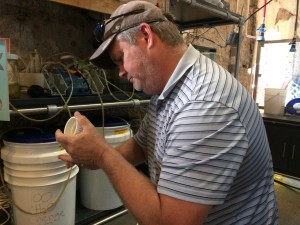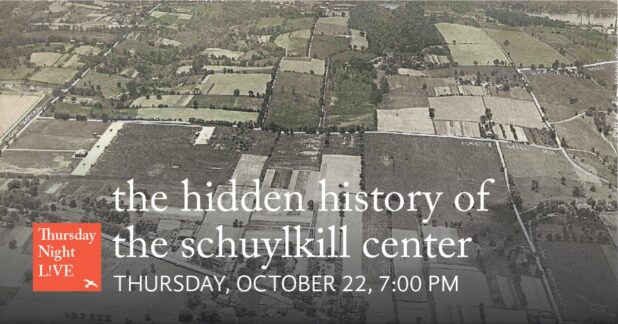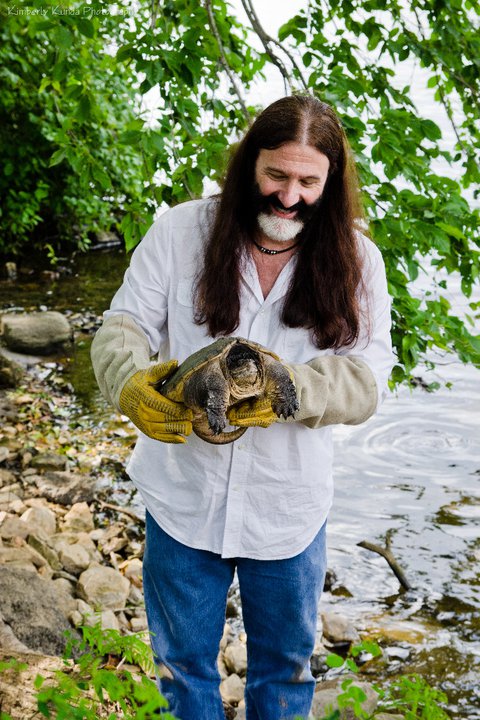
While Roxborough is famously home to numerous civil servants, especially cops and firemen, Andorra’s Lance Butler has among the most unusual city jobs.
He’s growing mussels. Thousands of mussels. To place back into the Schuylkill and Delaware rivers. And it’s surprisingly important work.
A senior scientist in Philadelphia Water’s Office of Watersheds, Lance was staring into a microscope last Thursday afternoon, measuring and assessing the health of baby mussels no larger than a grain of sand. He was sitting in a laboratory, what he calls “a living breathing laboratory,” tucked into the back of the Fairmount Water Works, Philly Water’s great museum of the city’s water history housed in the iconic building below the Art Museum. The lab doubles as the Mussel Hatchery, an exhibit in the Water Works where you can visit to learn about mussels too — and sometimes see Lance working.
The unassuming white plastic buckets that surrounded him on shelves, with a spaghetti tangle of clear plastic hoses running into and out of them, held thousands of baby mussels in various stages of their life cycles. Freshwater mussels are bivalves, two-shelled mollusks like clams and oysters, cousins of the marine versions you eat in marinara. Lance says these creatures are “bio-sentinels, the canaries in the river’s coal mine,” as they crave fresh, clean water, but have no ability to escape a pollution event — they can’t pick up and move away. If pollution strikes a river, mussels are doomed.
Consequently, over 70 percent of the world’s 700 mussel species are at risk of extinction, and freshwater mussels are among the most endangered American animals. Many were extirpated — made locally extinct — in the Delaware River basin, hence Lance’s project. But why does this matter? And why is the city spending money on this?
“Mussels have a huge impact on water quality,” Lance told me while unscrewing a jar containing baby yellow lamp mussels. As mussels anchor themselves in a river’s bottom and filter algae out of the water, “one mussel filters 10 to 20 gallons of water a day. With a million mussels in a river, that’s 20 million gallons of water. They remove nutrients, they remove solids, making the water more clear, and they remove harmful things like E. coli and other bacteria.”
Water is cleaner and safer for us because of the work of mussels.
That’s the key to why the city is investing in this. In addition to restoring to our rivers the plants and animals that belong there, Lance says, “mussels save money. If our water is cleaner going into our intake pipes, cleaning the water is easier and cheaper for the Water Department.” So spending money here saves money elsewhere.
And if you love to fish in the Schuylkill, you’ll especially love mussels. He says mussels practice “terraforming,” changing their habitat. “With mussels filtering the water, its clarity improves. Light can shine deeper into the water, so there is more submerged vegetation. And the plants hold sediment down, making better habitat for fish.” So the more mussels we have, the better the river is for fish (and fishing).
He also opened a larger lamp mussel for me, showing me a dark section inside the small soft body of what is a mother mussel. The dark spot was actually thousands of glochidia, larval mussels, hiding inside the mother. These larvae don’t have the bivalve shells and look like completely different organisms — but they are what hatches from mussel eggs. When the glochidia are ready for the next phase, some mama mussels have lures that attract the correct host fish over, and the female “spits” the glochidia at the fish, the larvae attaching themselves to the gills of the fish, “snapping like Pacman onto its gills.” And the larval mussels go for a ride.
“This is how they disperse themselves throughout a habitat,” he told me. “The fish are their Uber ride upriver.”
When ready, the glochidia transform again into small mussels and drop to the river bottom — where some species might live for as many as 100 years!
So the Mussel Hatchery also includes fish like yellow perch, the unwitting host in this extraordinary project. This week, Butler and other project scientists from the Partnership for the Delaware Estuary and the Academy of Natural Sciences will be discussing what happens to the 15,000 baby mussels now stored in holding ponds at several locations in the region, all products of this process. Ultimately, they will begin releasing mussels back into the wild. And hope they take.
Lance is also senior scientist in the long-awaited restoration of the Manayunk Canal, a project which is moving ahead and “should go out to bid next year. The canal will turn into a beautiful amenity for the community.” One of the project’s goals is to get water flowing back into and out of the canal again, to reconnect it to the river from which it has been severed. And mussels will definitely be a part of the picture.
Philly Water maintains a website, “The Mighty Mussel,” to learn more about this project (mightymussel.com), and for school teachers intrigued by this, mussels can visit your classroom as well, and your school can help bring mussels back to our rivers.
Visit the Mussel Hatchery soon, and perhaps you’ll see Roxborough’s own Lance Butler performing his critical work, bringing mighty mussels back to Philadelphia rivers.
Mike Weilbacher directs the Schuylkill Center for Environmental Education in Upper Roxborough, tweets @SCEEMike, and can be reached at mike@schuylkillcenter.org This blog was originally published in the Montgomery News September 5.




